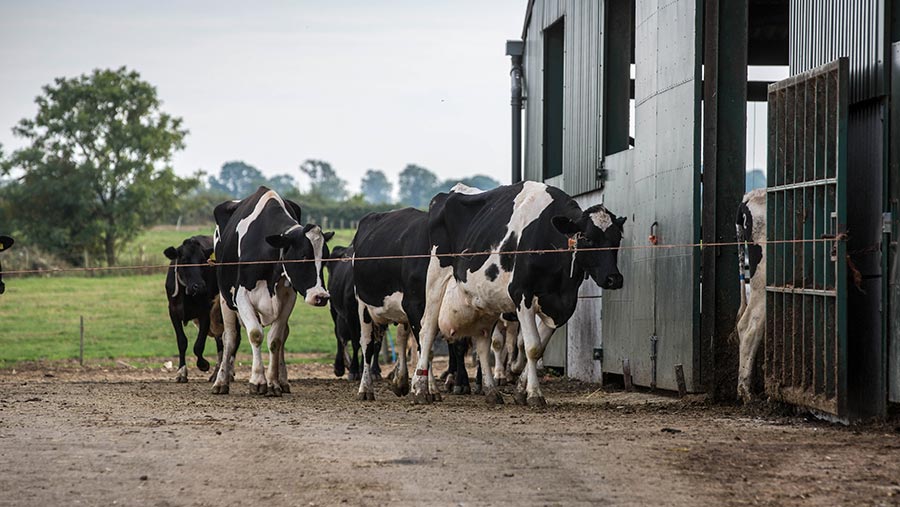British cattle industry improves on BVD, Johne’s and mastitis control
 © Tim Scrivener
© Tim Scrivener Excellent progress on bovine viral diarrhoea (BVD) eradication, Johne’s control and reducing mastitis rates across the UK are recent success stories laid out by an industry report, although some key welfare issues remain unsolved.
The fourth Cattle Health and Welfare Group (CHAWG) report, released this week, underlines dairy bull calves and beef herd fertility as areas still needing work.
Evaluating both dairy and beef herd performance across the UK, the bi-annual report shows the great progress the industry has made with mastitis and endemic disease control, with 86% of the milk supply now coming from farms in the Johne’s Disease Management Programme.
See also: Building for better herd health: Designing shed roofs
Meanwhile, 90% of Scottish holdings now boast a negative BVD status, following Scotland launching its eradication scheme in 2010.
Room for improvement: Bull calves still euthanised
Greater quantities of sexed semen and efficient bull-beef systems have reduced the amount of bull calves being exported and euthanised compared with historical levels.
However, some numbers have increased, with the report listing 2013 as a record low for calf euthanasia at 14%, after falling from 84,817 to 64,883 between 2006 and 2013.
Grain price increases were given as a possible reason for cereal-based bull finishing seeming less lucrative and the increase in bulls not making it into the beef chain.
Good: Dairy more fertile
Calving interval and mean age at first calving is showing a downward trend across dairy herds.
Average calving interval rose to a peak of 432 days in 2009 and sat at 405 days in 2017.
Meanwhile, dairy cows are calving almost two months earlier on average at 27.9 months compared with 29.2 months in 2007.
The report lists management and genetics as key areas of improvement:
- Genetic advances: The “better calving interval” index has been available to farmers since 2015
- Management advances: Heat detection, fertility management, genotyping youngstock and better decision-making through availability of fertility index
Good: Mastitis figures improving
Farms doing milk recording through NMR, QMMS, TotalVet and CIS are all showing improvements in key mastitis parameters.
The report said dry period new infection rates have fallen to 14% for NMR and TotalVet farms, but conversely lifted from 10% to 14% on CIS farms.
Average somatic cell count (cells/ml) 2010-2017
- NMR: 210,000 (2010), 184,000 (2015), 185,000 (2016), 179,000 (2017)
- CIS: 238,000 (2010), 207,000 (2015), 202,000 (2016), 184,000 (2017)
However, somatic cell counts (SCC) (see “Average somatic cell count”) are falling and chronic cases are falling.
Good: Beef heifers calving younger
British Cattle Movement Service data shows a gradual shift towards younger calving, the report explained.
Welsh suckler cows calve at an average of 33.2 months old, while English cows calve at an average of 32.8 months, a fall from 33.6 months and 33.4 months, respectively.
This has come while shaving four days off average calving interval in England, which now stands at 420 days, and two days less in Wales, which is at 426 days.
Non-severely disadvantaged suckler herds in England calved across a 13-week calving block, a massive reduction on the 18.2-week average in 2015.
Improvement: Autumn calvers seeing fertility slip
Some fertility figures for English autumn-calving suckler herds have deteriorated between 2015 and 2017.
While there were more cows calving in the first three weeks of the calving period, the report showed the length of calving periods grew to an average of 15 weeks, up from 11.9 in 2016 and 14.3 in 2015.
The report also showed that figures for empty calves and heifers increased from 5% to 11%, with the report showing a 6% drop in cows/heifers scanned in-calf.
Improvement: Slow uptake of preventative vetting
Farm spending on medicines, individual animal treatment (including fertility visits) and emergency care still “far outstrips” herd health planning.
This is despite most modern cattle vets pursuing preventative herd health planning, training and diagnostic services as models for their future businesses, said the report.
Among the reasons why farmers could deem herd health planning unnecessary were perceived time, money and value constraints and the suggestion that vets are not marketing services well enough.
Improvement: Schmallenberg rears its head
Schmallenberg virus (SBV) was the number one cause of abortion in 2017, rising to a peak of 5.5% of diagnosable submissions, according to Animal and Plant Health Agency data.
This followed a rise in mainland Europe in 2016 and three relatively quiet years since SBV was first identified in 2012.
Areas affected were across southern Scotland, through the Borders and into Yorkshire and Lancashire. Other areas were Gwynedd and Anglesey, Staffordshire and the Home Counties, ranging across the Fens to East Anglia.
Improvement: BVDFree England ‘remains a challenge’
England’s national programme to engage 50% of the herd in BVD control by 2021 is finding it challenging to determine overall numbers and achieve a fully co-ordinated approach.
Growing numbers of farms have eliminated or been accredited for BVD, but many have neglected to join BVDFree, the report said.
As of June 2018, a total of 1,242 registered cattle holdings and 175,537 cattle were covered by the scheme, just over 9% of the national herd.
